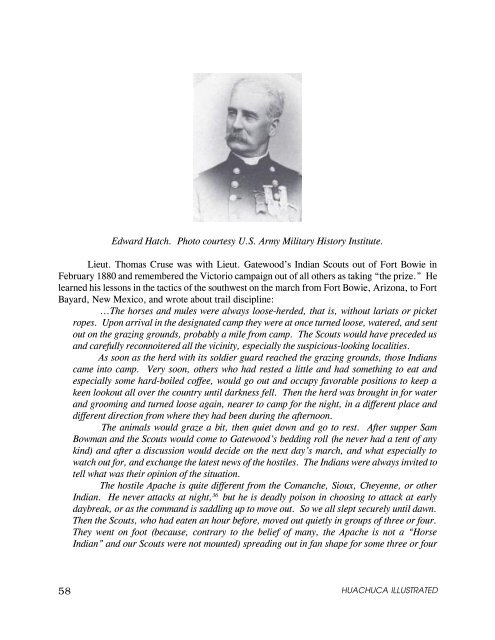Apache Campaigns - Fort Huachuca - U.S. Army
Apache Campaigns - Fort Huachuca - U.S. Army
Apache Campaigns - Fort Huachuca - U.S. Army
You also want an ePaper? Increase the reach of your titles
YUMPU automatically turns print PDFs into web optimized ePapers that Google loves.
58<br />
Edward Hatch. Photo courtesy U.S. <strong>Army</strong> Military History Institute.<br />
Lieut. Thomas Cruse was with Lieut. Gatewood’s Indian Scouts out of <strong>Fort</strong> Bowie in<br />
February 1880 and remembered the Victorio campaign out of all others as taking “the prize.” He<br />
learned his lessons in the tactics of the southwest on the march from <strong>Fort</strong> Bowie, Arizona, to <strong>Fort</strong><br />
Bayard, New Mexico, and wrote about trail discipline:<br />
...The horses and mules were always loose-herded, that is, without lariats or picket<br />
ropes. Upon arrival in the designated camp they were at once turned loose, watered, and sent<br />
out on the grazing grounds, probably a mile from camp. The Scouts would have preceded us<br />
and carefully reconnoitered all the vicinity, especially the suspicious-looking localities.<br />
As soon as the herd with its soldier guard reached the grazing grounds, those Indians<br />
came into camp. Very soon, others who had rested a little and had something to eat and<br />
especially some hard-boiled coffee, would go out and occupy favorable positions to keep a<br />
keen lookout all over the country until darkness fell. Then the herd was brought in for water<br />
and grooming and turned loose again, nearer to camp for the night, in a different place and<br />
different direction from where they had been during the afternoon.<br />
The animals would graze a bit, then quiet down and go to rest. After supper Sam<br />
Bowman and the Scouts would come to Gatewood’s bedding roll (he never had a tent of any<br />
kind) and after a discussion would decide on the next day’s march, and what especially to<br />
watch out for, and exchange the latest news of the hostiles. The Indians were always invited to<br />
tell what was their opinion of the situation.<br />
The hostile <strong>Apache</strong> is quite different from the Comanche, Sioux, Cheyenne, or other<br />
Indian. He never attacks at night, 36 but he is deadly poison in choosing to attack at early<br />
daybreak, or as the command is saddling up to move out. So we all slept securely until dawn.<br />
Then the Scouts, who had eaten an hour before, moved out quietly in groups of three or four.<br />
They went on foot (because, contrary to the belief of many, the <strong>Apache</strong> is not a “Horse<br />
Indian” and our Scouts were not mounted) spreading out in fan shape for some three or four<br />
HUACHUCA ILLUSTRATED

















